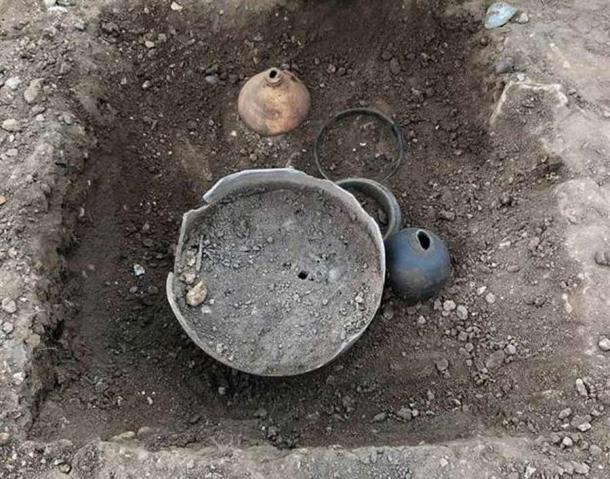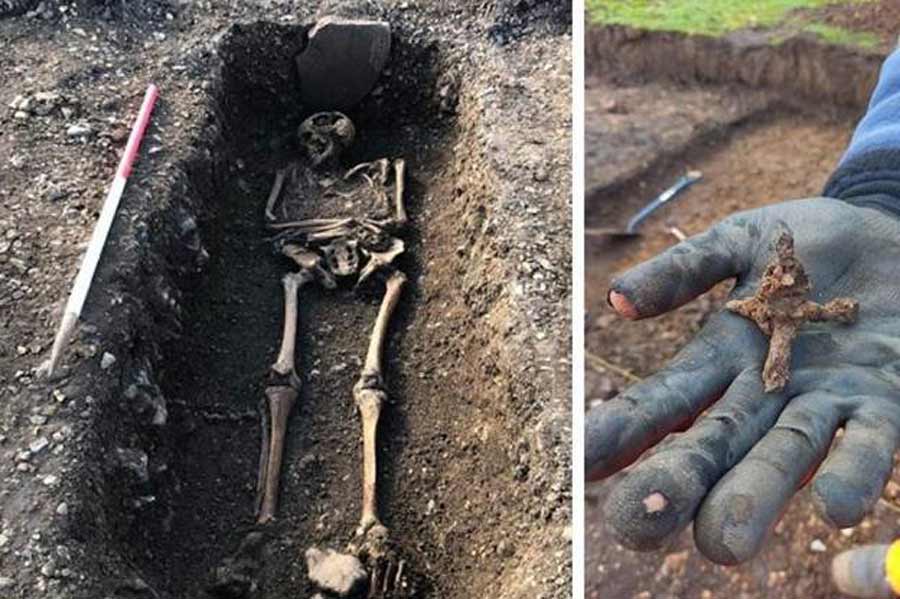Archaeologists Stumble Upon Key Romano-British Trade Center
Archaeologists performing excavations near Bishop’s Stortford, an historic market town in Hertfordshire, England, have uncovered the ruins of a Romano-British settlement that served as a commercial center along a Roman roadway that had once passed through the area, the Daily Mail reports. In addition to the Romano-British settlement, researchers from the private contractor Oxford Archaeology also found evidence of facilities and various businesses that would have served the needs of travelers, essentially duplicating the function of a modern roadside service station.
This “once in a lifetime discovery” was unearthed at the site of a planned football field at Bishop Stortford’s Grange Paddocks leisure center. As required by law, the East Herts District Council hired Oxford Archaeology to perform an exploratory search of the area, to make sure the coming construction project wouldn’t destroy any valuable artifacts. The archaeologists weren’t expecting to find much of anything, but they’ve been delighted to have those expectations proven wrong.
A One-Stop Romano-British Settlement for Travelers and Traders
A team of about 30 diggers began excavating the site in southcentral England, which is located about 35 miles (55 kilometers) north of London, in February. They began unearthing artifacts and buried structural features almost immediately, and they were quickly able to identify what they’d found as the remains of an ancient Romano-British settlement.
In the words of project officer Neal Mason, the Oxford Archaeology team found “everything you could possibly hope for from a Roman site,” including the remains of the Roman road, signs of intense commercial and hospitality-related activity, a bounty of artifacts including Roman coins and pottery, and even a Roman cemetery featuring many undisturbed burials.
- Finest Romano-British sculpture ever found in London
- Two Roman Coffins with Celtic Motifs, One Containing an Adult and Infant, Found in England
To the archaeologists, it was the presence of the ancient equivalent of a modern roadway service area that generated the most excitement. Among the evidence that proved its existence were the ruins of an ancient inn where travelers could stay overnight and/or find food and refreshments. There was also a blacksmith’s facility on site, the archaeologists found, and also a religious temple where visitors could take time to pray or meditate.
Other types of traveler-friendly facilities were present as well, clustered together for the convenience of travelers passing through during their journeys across the landscape of the Roman province of Britannia.
“It's quite like a services [station],” proclaimed Oxford Archaeology’s project manager Andrew Greef. “You'd have been able to stop. Everything would have been available for you at the roadside.”

The most well-preserved skeleton found at the Romano-British settlement near Bishop’s Stortford, which was laid out on an east-west alignment. (East Herts District Council)
The archaeologists believe the site was likely built by the Romans as far back as the first century AD and would have remained in use for a few centuries after that. Britain was occupied by the Romans from 43 to 410 AD, so all activity at the site would have taken place within that time frame.
While parts of the development were clearly set up to serve the needs of travelers, the site also doubled as a bustling commercial center. Some of the artifacts that showed trading was taking place include several coins dating back to the reign of the infamous Roman emperor Nero (54 to 68 AD), multiple weighing scales, many pots for transporting goods, and metal tools that would have been valued on markets of exchange.
“We’re getting a lot of evidence for trade and commerce going on on-site,' Greef said. “I think you're looking at some kind of stopover point, or something associated with supply and trade, rather than just your average settlement.”
In other words, many travelers may not have been passing through on their way to somewhere else, but instead came to Bishop’s Stortford purposely in order to trade or purchase valuable goods.
In addition to the artifacts and commercial ruins, the archaeologists have also excavated sections of the ancient road, which are quite well-preserved. Greef noted that the site and associated road were perfectly located to facilitate vigorous trade.
“We're positioned almost halfway between Roman Colchester and St. Albans,” he said. 'So we're on a major Roman route, Stane Street, and it's just about a good day's march from S.t Albans. It's also at a river crossing, which is a strategic location, and they would have been utilizing the River Stort for transporting goods and materials, so you're essentially at a crossroads.”
In one excavated ditch the archaeologists found a cache of oyster shells, proving that the site’s trade links extended all the way to the seacoast, 40 miles (65 kilometers) away.

Evidence of a Roman cremation at the site, where some of the graves also had evidence of early Christian burial practices. (East Herts District Council)
A Christian Cemetery in Roman Britain
The cemetery discovered during the excavations is an especially intriguing find, because it was actually used by those who practiced the Christian religion. This means it would have been installed during the third of fourth century, likely in the latter stages of the site’s occupation.
There have been approximately 100 graves found so far about half of which contained intact skeletons, and each of the bodies was lain facing east-to-west. This positioning was traditional in early Roman Christianity, as it meant the deceased would be facing the direction from which Christ would emerge when he returned to the earth for the Second Coming.
The Oxford Archaeology team speculates that the residents of the area in ancient times may have been Roman veterans who were given land as a reward for their past military service. Notably, the artifacts excavated at the Bishop’s Stortford site include a fairly significant number of weapons and other types of military items.
“One thing that's really intriguing is the amount of military-related objects and getting to the bottom of how this relates to how the army would've been using the site,” Greef said. “So that's something we're going to be looking at further in the post-excavation process.”
The Tip of the Roman Iceberg?
As the Oxford Archaeologists indicate, finding an undiscovered Roman site of such magnitude in a relatively out-of-the-way location is most unusual.
“For such a small area, the sheer quantity of archaeology and the amount of finds is more what you'd find in an urban center like London really,” Andrew Greef stated. “It's definitely significant, you don't get very many opportunities to excavate roadside settlements along the lines of major routes.”
- Rare Ancient Millstone Found Decorated With A Roman Phallus Carving
- A Fascinating Roman Industrial Complex Has Been Excavated In England
And there may be more remnants of the ancient Roman settlement waiting to be found. The archaeologists confirm that parts of the temple found there extend beyond the planned site of the football field, meaning the site’s overall footprint could be quite expansive.
It may be necessary to obtain special permission to extend the dig beyond the initial area approved for excavations. If such permission is granted, there quantity of Roman ruins and artifacts discovered in Bishop’s Stortford could increase substantially in the coming months and years.
Top image: English archaeologists have stumble upon a once-in-a-lifetime Romano-British settlement near Bishop’s Stortford, Hertfordshire. This skeleton and a caltrop, a Roman era area denial weapon, similar to police spikes used to stop cars today, were unearthed at the Grange Paddocks site. Source: East Herts District Council
By Nathan Falde




















Comments
I'm just curious that they called a pot of ashes a Roman cremation. Was it common to grind the bones to powder? Because bones don't burn. The ashes of modern cremation are not ashes at all. They are bone dust. They do grind them up, and then call them ashes. And pagans think Christians are weird, lol.